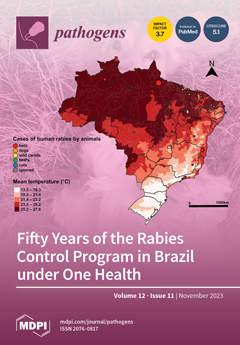Candidiasis, caused by opportunistic fungal pathogens of the
Candida genus, poses a significant threat to immunocompromised individuals. Natural compounds derived from medicinal plants have gained attention as potential sources of anti-fungal agents. Ajwa dates (
Phoenix dactylifera L.) have been recognized for their
[...] Read more.
Candidiasis, caused by opportunistic fungal pathogens of the
Candida genus, poses a significant threat to immunocompromised individuals. Natural compounds derived from medicinal plants have gained attention as potential sources of anti-fungal agents. Ajwa dates (
Phoenix dactylifera L.) have been recognized for their diverse phytochemical composition and therapeutic potential. In this study, we employed a multi-faceted approach to explore the anti-candidiasis potential of Ajwa dates’ phytochemicals. Utilizing network pharmacology, we constructed an interaction network to elucidate the intricate relationships between Ajwa dates phytoconstituents and the
Candida-associated molecular targets of humans. Our analysis revealed key nodes in the network (STAT3, IL-2, PTPRC, STAT1, CASP1, ALB, TP53, TLR4, TNF and PPARG), suggesting the potential modulation of several crucial processes (the regulation of the response to a cytokine stimulus, regulation of the inflammatory response, positive regulation of cytokine production, cellular response to external stimulus, etc.) and fungal pathways (Th17 cell differentiation, the Toll-like receptor signaling pathway, the C-type lectin receptor signaling pathway and necroptosis). To validate these findings, molecular docking studies were conducted, revealing the binding affinities of the phytochemicals towards selected
Candida protein targets of humans (ALB–rutin (−9.7 kJ/mol), STAT1–rutin (−9.2 kJ/mol), STAT3–isoquercetin (−8.7 kJ/mol), IL2–β-carotene (−8.5 kJ/mol), CASP1–β-carotene (−8.2 kJ/mol), TP53–isoquercetin (−8.8 kJ/mol), PPARG–luteolin (−8.3 kJ/mol), TNF–βcarotene (−7.7 kJ/mol), TLR4–rutin (−7.4 kJ/mol) and PTPRC–rutin (−7.0 kJ/mol)). Furthermore, molecular dynamics simulations of rutin–ALB and rutin-STAT1 complex were performed to gain insights into the stability and dynamics of the identified ligand–target complexes over time. Overall, the results not only contribute to the understanding of the molecular interactions underlying the anti-fungal potential of specific phytochemicals of Ajwa dates in humans but also provide a rational basis for the development of novel therapeutic strategies against candidiasis in humans. This study underscores the significance of network pharmacology, molecular docking and dynamics simulations in accelerating the discovery of natural products as effective anti-fungal agents. However, further experimental validation of the identified compounds is warranted to translate these findings into practical therapeutic applications.
Full article






